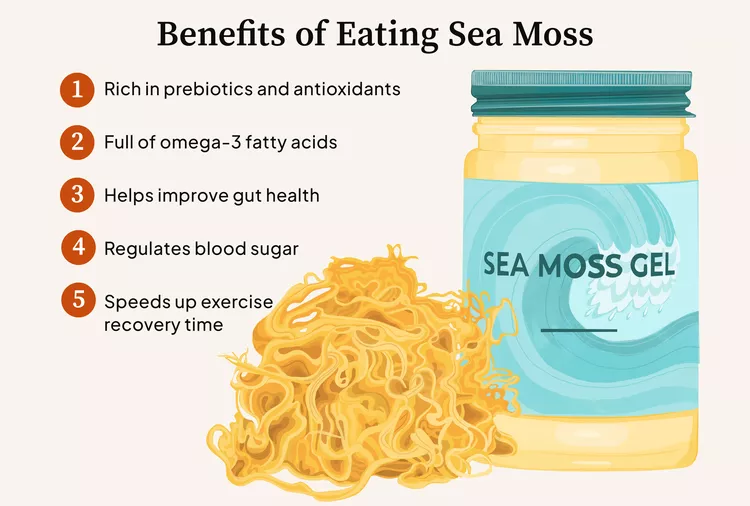As health and sustainability continue to take precedence for consumers across the globe, the popularity of edible aquatic plants has shot up like never before. Enter sea moss, a sea green that addresses these concerns—and then some. Here’s what to know about its health benefits, eco-friendliness, and how to use it in cooking and all of its forms.
What is sea moss?
Sea moss is a type of seaweed most commonly found growing naturally in coastal regions of the Atlantic Ocean, from North America to Europe. Evidence of human use dates back nearly 14,000 years. Often referred to as Irish moss or red seaweed, this plant was used for medicinal properties in China starting around 600 BC and as a food source in the British Isles in 400 BC. It even benefited the Irish in the 1800s, helping to address nutritional deficiencies during the Irish Potato famine.
Fast forward to today, and this plant is harvested globally by fishermen or seaweed farmers who handpick it from the seafloor. You’ll find sea moss in red (the most common), yellow, brown, and black varieties. You’ll also often find a component of this plant, carrageenan, added to food products as a thickening agent.
Benefits of Eating Sea Moss
Although sea moss is commonly added to processed foods, it still brings an abundance of health benefits to any meal. Here are some of its most impressive features.
Improves Gut Health
Sea moss is rich in both soluble and prebiotic fiber. It works so effectively as a thickening agent in food because this fiber helps to create a gel when it comes into contact with water (or fluids found in the gastrointestinal tract). This gel promotes digestive regularity and motility. The prebiotics found in sea moss serve as food for the gut microbiome, a key player in overall digestive health.
Boosts Thyroid Health
When it comes to maintaining our thyroid health, consuming enough of the mineral iodine and the amino acid tyrosine is impactful. Sea moss is an excellent source of both nutrients—this is especially valuable, as it can be difficult to get enough iodine on a daily basis. In fact, iodine can be so tricky to come by that iodized salt was created to address the public health concern of inadequate intake across the country.
Loaded with Plant Compounds
This sea green is also full of plant compounds that have been shown to boost immune health through their anti-inflammatory and antioxidant properties.
Benefits Heart Health
The soluble fiber found in red seaweed benefits not only digestion but also heart health, as it can reduce dietary cholesterol in the gut. Sea moss is also full of heart-healthy omega-3 fatty acids that lower bad cholesterol levels while increasing healthy cholesterol. Fish that are a great source of omega-3s (like salmon) are so rich in fatty acids because of the aquatic plants they consume, and sea moss happens to be one of the best aquatic plant sources.
Additional Benefits
Some other health benefits of sea moss include its ability to help regulate blood sugars and speed up exercise recovery time (because of its taurine content).
The Sustainability of Sea Moss
If the health benefits of sea moss weren’t enticing enough, this aquatic gem is also a champion of sustainability. Generally, seaweeds are likely to be incredible environmentally-friendly food options as they naturally absorb carbon dioxide: A half-square meter of sea moss can absorb one kilogram of CO2, which is more than a small forest can accomplish.
Sea moss also regenerates quickly, making it an ideal food source with minimal impact on the sea life that’s reliant upon it. While there are limitations to farming this plant (it must be grown in salt water), vertical ocean farming systems are being created to more efficiently meet consumer demands.
Wildcrafting is also a common sea moss harvesting practice, in which the plant is harvested in its wild form. This practice focuses on sustainability and prioritizes leaving enough for the animals that use it as a food source, too.
How to Incorporate Sea Moss into Your Diet
Now that you’re aware of all of the benefits of this aquatic superfood, you probably want to know how you can add it to your daily menu. Before diving in (pun intended), knowing where you’re buying your sea moss and if they’re sourcing it sustainably is important.
It’s unlikely you’ll find sea moss in its whole form in the grocery store, but it may be more accessible in supplement form. Use it as a vegan gelatin substitute or thickening agent for desserts like ice cream, puddings, Jell-O spin-offs, and more. You can also add it to smoothies, oatmeal, and homemade nut milk as both a thickener and a nutrition supplement. Search your local specialty food stores and online to get your hands on sea moss in its natural form, which lends itself beautifully to salads, egg dishes, dips, sauces, soups, and sandwich toppings.
Frequently Asked Questions
-
Does sea moss help with acne?
Because sea moss contains a substantial amount of sulfur, it's been promoted as a topical application to help absorb excess oils in the skin, which can lead to acne or other dermatological problems. Due to its texture, it is also used as an exfoliator. However, research hasn't been done to prove its effectiveness.
-
Are there any possible negative outcomes from using sea moss?
If you use too much sea moss, you can develop increased iodine levels, which can lead to stomach problems, including nausea and diarrhea. In addition, unless the conditions for sea moss growth are regulated, it can be difficult to be sure there are no toxins or heavy metals in it.




















